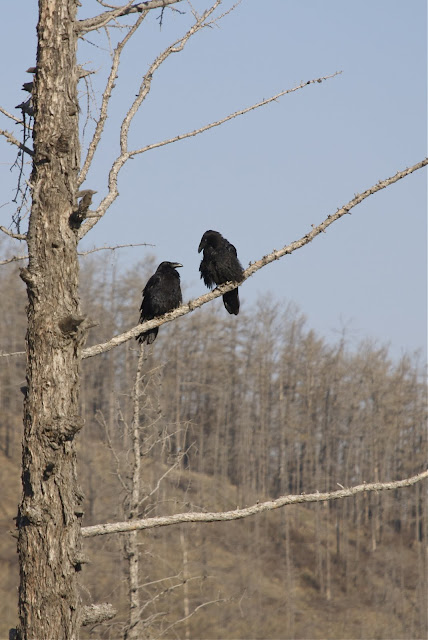I’d read that the Mongolian language sounds something like two cats, hissing and spitting at each other with the intermittent reprieves of one coughing up a hairball in the other’s general direction. While this description might appear unjust to the outsider, I am amazed by its accuracy. Every morning, I climb the steep foothills beyond the university for a view of the city, and I am sure I pronounce more Mongolian words through my laboured breathing than I could ever hope to accomplish through careful study. How distressing it is for a Canadian, unable to properly pronounce thank you, please, excuse me, sorry!
Food
Westerners will tell you that Mongolian food is not very good. This isn’t really true. At its very worst, Mongolian food is interesting. I firmly believe that you can eat anything if it has been salted heavily and boiled long enough, and the Mongolians do both of these things with great proficiency. Horse is delicious, you can’t ruin mutton, and fermented dairy products are a convenience for the lactose intolerant.
 |
| Enjoying a bottle of fermented camel's milk. Behind me is my attempt at making sense of the Cyrillic alphabet. |
Music
Through a series of fortunate events beginning in Saskatoon, Dayle and I ended up at the Canadian ambassador’s house for a Sunday afternoon BBQ. One of the diplomats I met there works at the Canadian embassy in Beijing and is involved in the belaboured and hellish negotiations of sending some panda bears to Canada. It may be this untoward responsibility that has led him to become familiar with every bar and pub of consequence in UB. (Actually, he is a remarkably cheerful person, maybe owing to the happy knowledge that the mother of his four children is a Taiwanese supermodel.) Anyway, this was all very fortunate for me, because he invited us to see a Mongolian band playing at Ikh Mongol that evening. I went, and the set was… really good. Actually, I think my jaw dropped. I doubt the following will do justice, but visit the links to hear traditional Mongolian instruments and throat singing.
Ulaanbaatar
We have been concentrating on a number of things in UB, and I’m not sure how to summarize them without being tedious.
Most of our time has been at the State University of Agriculture. We are compiling a database of possible funding opportunities relevant to collaborative research between our universities, and we are helping to write grant proposals in English.
We attended a conference titled A Case for Complexity: Accounting for Diversity in Mongolian History, Culture, and Ecology. Among those at the conference: a social anthropologist returning from a winter with Gobi nomads, studying herders’ perceptions of government assistance following dzud (winter disasters); a Xiongnu Iron Age archeologist; an agricultural economist; a Tibetan freelance photographer who documents disappearing indigenous cultures; two somewhat confused veterinary students.
The State University of Agriculture is associated with the Mercy Corps project, “Market Opportunities for Rural Entrepreneurs.” (http://www.mercycorps.org.mn/index.php?cid=188) We became involved with a Mercy Corps training course organized by the college for members of "extended producer groups,” which are cooperatives of rural entrepreneurs (mostly herders). Dayle gave a presentation (translated by the agricultural economist) on Canadian livestock production marketing. The point was to provide an overview of how livestock production is organized and marketed in Canada, as a way of providing ideas for local producer groups that are currently discussing how best to organize themselves and target consumers. From what I could tell, she was received rather well, with animated discussion and questioning. The herders expressed disbelief when she claimed Canadian dairy cows are milked three times a day, and demanded the price of a Canadian heifer when she mentioned production of over 30 L. They didn’t appear especially interested in our quota system. They erupted into giggles when she described how sheep producers in Canada have targeted ethnic groups. They laughed and scribbled furiously on their note pads when she alleged that foreigners coming to Mongolia are willing to pay money to experience a few days of a herder’s life and work, and to buy hand-made products from them. When she claimed that mare urine is harvested for pharmaceutical use, our translator asked her to repeat herself three times before he would believe her.
 |
| This gentleman thought I was exotic enough for him to request a picture with me. He has blue eyes. |
 | ||
| A room full of herders and other producers at Dayle's presentation |
 |
| Ulaanbaatar |
 |
| Cashmere- separating the hairs from the wool |
 |
| Cashmere production- spinning |
 |
| Spring |
 |
| Dancing on top of a hill |
…And we have been hectically organizing the remainder of our stay in Mongolia (not enough time!) and noncommittally studying the language before leaving for the countryside. So that's me caught up, more or less.



























